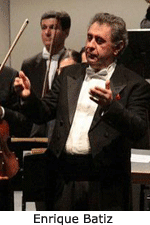Radio Concert Season
National Radio Orchestra - Live Broadcast
Friday, 5 February 2010
, 19.00
 The year was 1839. Mendelssohn was adding the final touches to his Ruy Blas for a charity concert, but the respective overture did not satisfy him completely, therefore the score wasn’t published until the composer’s death. The masterpiece (based upon Victor Hugo’s homonymous play) unfolds its plot at King Carlos II’s Spanish court, presenting the torments of a ‘humble’ poet, in love with the almighty Queen, a poet who was turned by Don Salusto into a demeaning revenge instrument. Thus, we are introduced in the atmosphere of 17th-century Spain, where the extremely harsh laws passed by the Royal Court and the deadly plots are taken to a higher level just by adding love and revenge to the equation.
The year was 1839. Mendelssohn was adding the final touches to his Ruy Blas for a charity concert, but the respective overture did not satisfy him completely, therefore the score wasn’t published until the composer’s death. The masterpiece (based upon Victor Hugo’s homonymous play) unfolds its plot at King Carlos II’s Spanish court, presenting the torments of a ‘humble’ poet, in love with the almighty Queen, a poet who was turned by Don Salusto into a demeaning revenge instrument. Thus, we are introduced in the atmosphere of 17th-century Spain, where the extremely harsh laws passed by the Royal Court and the deadly plots are taken to a higher level just by adding love and revenge to the equation. The year was 1940. Aram Haciaturian was finishing up his Violin and Orchestra Concerto in D minor. Receiver – David Oistrah, the man who eventually performed it in Moscow, for the first time ever. The collaboration between the composer and the musician did not stop there. The famous violinist offered the Tiflis - born Armenian his advice but also a specific cadence to be used in the first part of the opus. It is worth mentioning that this concerto (which received the Lenin Art Award in 1941) also has a variant for flute and orchestra (transcription), created by Jean-Pierre Rampal in 1968, with the composer’s blessing.
1850 was drawing to an end. Robert Schumann was writing his third and most luminous of symphonies (it would actually be his last because the fourth, written in 1841, was revised ten years later). Later named ‘Renana’, (not by the composer), the symphony is a musical apotheosis of the land that has inspired generations of German composers for years. Five parts blend into the architecture of his music, with Lebhaft (lively), Sehr massig (extremely measured), Nicht schenell (not fast), Feierlich (festive) and, again, Lebhaft (lively) tempo directions, the penultimate also carrying the note ‘in the spirit of the music played during a solemn ceremony’, as an echo of the thoughts gathered during a visit to the Cologne Dome.
Three works, three composers, three artistic identities.
You will be the only common denominator, the only explorers of artistic impressions taken from two very different centuries of music… The National Radio Orchestra directed by Enrique Batiz, with violinist Robert Bokor as lead soloist.
Sorina Goia
Translated by Iulian Arabagiu and Andreea Banciu
MA students, MTTLC, Bucharest University
Translated by Iulian Arabagiu and Andreea Banciu
MA students, MTTLC, Bucharest University
Return to archive Radio Concert Season














